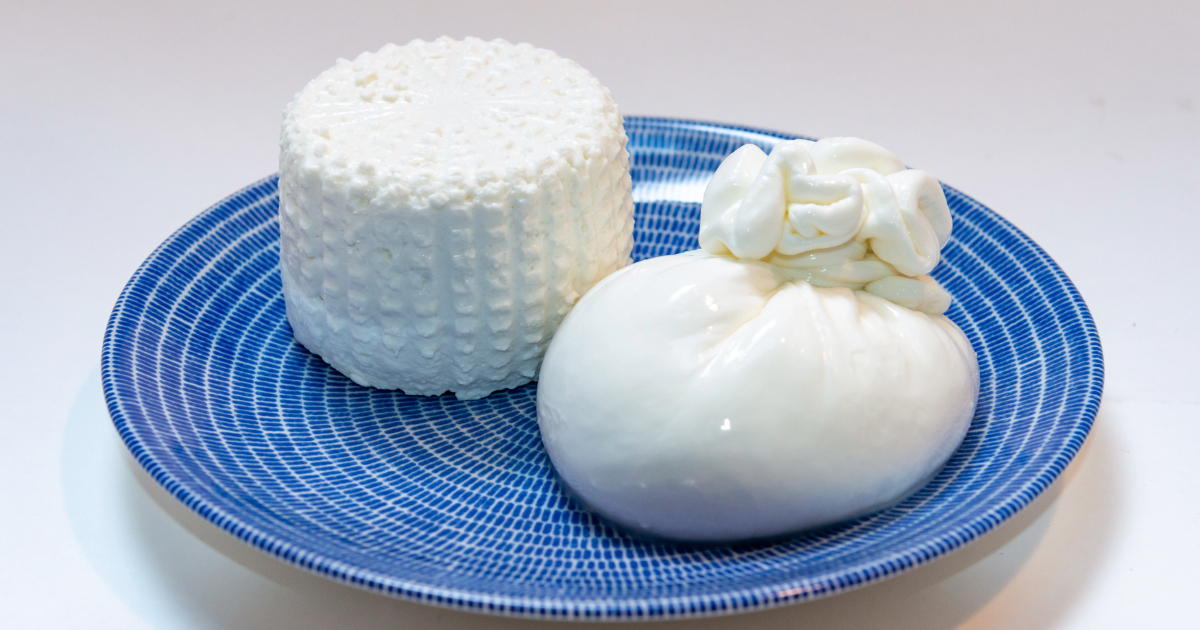Have you ever stood in front of the cheese section trying to decide between ovoline cheese and burrata? You pick one up, notice they look pretty similar on the outside, and wonder what exactly makes them different.

Ovoline and burrata may appear comparable, but they vary in some key ways.
What Are Ovoline and Burrata Cheeses
First, let’s start with a quick rundown of each cheese:
Ovoline is a type of mozzarella cheese. It's molded into an egg shape and weighs about 4 ounces. Ovoline has a mild, smooth flavor and firm yet pliable texture.
Burrata originated in southern Italy in the 1900s. It consists of an outer mozzarella shell filled with stretched curds and fresh cream or stracciatella. Burrata is soft, rich, and oozes when cut open.
Key Takeaway: Burrata features a mozzarella exterior enclosing a creamy stracciatella interior. Ovoline is a firm, egg-shaped mozzarella cheese.
What Exactly is Ovoline Cheese?
Ovoline falls under the broad mozzarella cheese family. As mentioned earlier, ovoline:
- Is molded into an egg shape
- Weighs around 4 ounces
- Has a firm yet pliable texture
- Features a mild, milky flavor
During production, ovoline is packed in brine to help preserve that fresh mozzarella taste. Many grocers sell it submerged in this salty liquid.
Because ovoline classified as mozzarella cheese, you can use it similarly:
- On pizzas
- In lasagnas or baked pastas
- Grilled or pan fried
- In Caprese salads with tomato and basil
- Served with bread and olive oil
Ovoline’s small size makes it perfect for popping whole into your mouth too! The firm texture stands up well to high heat without turning rubbery. It also slices neatly for sandwiches or cheese boards.
What is Burrata Cheese?
Let’s switch gears and learn about burrata:
As mentioned earlier, burrata consists of:
- A mozzarella exterior
- An interior filled with stracciatella (cheese curds and cream)
The word burrata even stems from the Italian word for butter, “burro,” noddding to that lush creamy center.
While the outer shell mirrors fresh mozzarella, cutting into burrata reveals gooey, stringy stracciatella inside. This fluffy filling differentiates burrata from other Italian cheeses.
Because of the delicate stracciatella, burrata shines when enjoyed fresh and uncooked. The filling would break down if you tried melting burrata like mozzarella.
Comparing Ovoline and Burrata Side-by-Side
Let's break things down clearly in this side-by-side comparison:
| Cheese Variety | Ovoline | Burrata |
|---|---|---|
| Other Names | Mozzarella ovoline | - |
| Place of Origin | Italy | Southern Italy |
| Date Created | 12th century | 1900s |
| Main Ingredients | Cow's milk, rennet | Cow's milk, rennet |
| Texture | Firm, pliable | Soft, creamy |
| Taste | Mild, milky | Rich, buttery |
| Interior | Solid | Filled with stracciatella |
| Best Uses | Grilling, baking, frying | Serving fresh with bread or in salads |
As shown in the table, while both cheeses hail from Italy and use similar base ingredients, they differ in age, texture, and best uses.
The Cheesemaking Process: Ovoline vs. Burrata
Ovoline and burrata start off similarly, then diverge when that signature stracciatella gets added to make burrata:
Ovoline Cheesemaking Process
- Warm milk, add culture and rennet to form curds
- Drain off whey and collect curds
- Stretch and mold curds into egg shape
- Package in brine
Burrata Cheesemaking Process
- Warm milk, add culture and rennet to form curds
- Drain off whey and collect curds
- Stretch some curds into a thin mozzarella pouch
- Mix remaining curds with cream to create stracciatella
- Stuff stracciatella into the mozzarella pouch
- Seal pouch
- Submerge in cool water to set shape
- Package in brine
As you can see, stretched and molded curds make up all of ovoline's interior, while burrata hides that creamy surprise inside.
How To Use Each Cheese
Since you understand their backgrounds now, let’s explore the best ways to eat ovoline and burrata:
Serving Ovoline
- On pizza or in baked ziti
- Layered in lasagna
- Grilled, fried, or baked whole
- Skewered for Caprese bites
- Added to antipasto spreads
- Served with bread and olive oil
Serving Burrata
- Dolloped over pasta or pizza after baking
- Spread on bread or bruschetta
- Added to fresh salads
- Served with olive oil and crackers
- Used as a dip with vegetables
- Enjoyed straight out of the package!
Ovoline holds up well to high heat, while burrata comes alive when enjoyed fresh and unmelted. Those serving ideas should give you plenty of ways to enjoy each cheese's strengths.
FAQs
Is ovoline the same as mozzarella?
Yes, ovoline falls under the mozzarella family of Italian cheeses. It simply refers to mozzarella cheese shaped specifically into an egg form.
Is burrata better than mozzarella?
Whether burrata or mozzarella rates as “better” comes down to personal preference! Burrata offers a richer, creamier bite than fresh mozzarella. However, mozzarella works better for melting or baking. Both shine in different applications.
Can you bake with burrata?
Burrata has too high moisture and delicate texture to bake well. Baking would cause the stracciatella filling to break down. It’s best enjoyed fresh and unmelted.
What wine pairs best with each cheese?
Bright, acidic wines cut through ovoline’s milky flavors nicely. For burrata’s buttery notes, try medium-bodied whites with hints of oak or toast. Bubbly prosecco also accents both cheeses beautifully.
Conclusion
Ovoline is a type of mozzarella cheese formed into an egg shape.
Burrata is a mozzarella shell filled with creamy stracciatella
While they look similar, ovoline offers a firm, mild bite while burrata oozes with rich stracciatella when sliced open.

